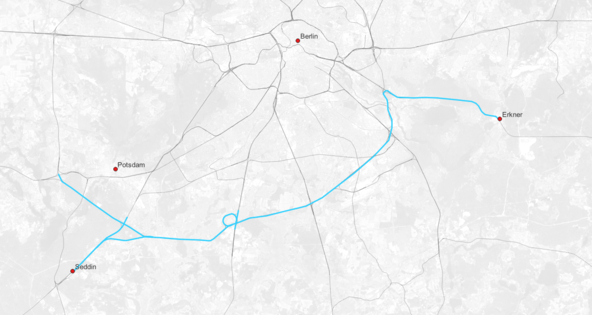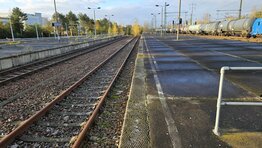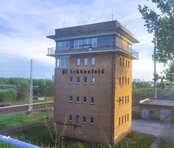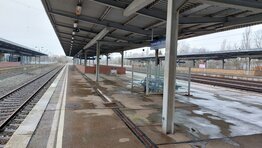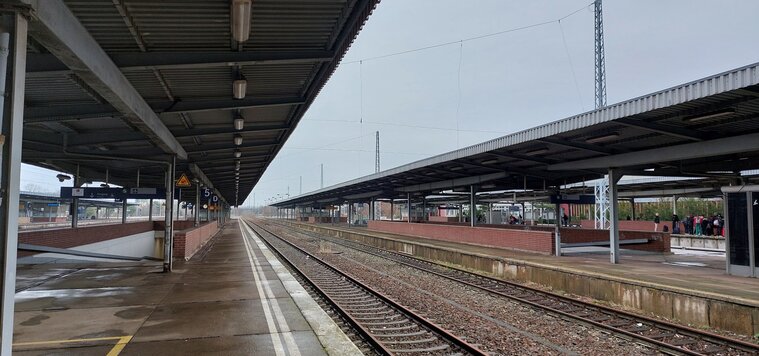
Erkner – Seddin
To ensure interoperability between EU countries, the section between Erkner and Seddin will be equipped with ETCS. This will extend the ETCS coverage area of the neighboring project “Border crossing Poland: Poland – Frankfurt/Oder – Erkner” to the Seddin marshalling yard, enabling seamless ETCS operation for freight traffic all the way to the destination station.
Project duration
Route data
| Line from | Erkner |
|---|---|
| Line to | Seddin |
| Kilometers of line to be equipped | 102 km |
| Route number(s) | Contains 27 route numbers |
Planned actions
| ETCS | Level 2 with signals |
|---|---|
| Interlocking(s) | 19 Interlockings |
| Scope of equipment |
|
| Planned speed | 120 - 160 km/h |
Technologies
Contact
Disclaimer
The dates shown are legally non-binding forecasts based on the current status. The forecasts are in no way intended to establish any kind of legal claim whatsoever that completion will take place by the specified date and that use will be possible. For these reasons, the information should also not be used to make or prepare business decisions, for example, but not conclusively, with regard to the vehicle equipment or the compatibility between the vehicles and the infrastructure. If you have any questions, particularly regarding technical network access or obtaining binding information, please contact your customer advisor.
Most of the infrastructure projects are still in the planning phase, which means that the information provided on these pages reflects the current planning status and is updated regularly.
With the European Train Control System (ETCS), EU member states have agreed on a uniform technology to ensure cross-border compatibility between tracks and vehicles. ETCS enables interoperability in European rail freight transport, which is why trains will in future be able to run continuously in ETCS mode from the German-Polish border to the Seddin marshalling yard.
Seddin is home to one of DB InfraGO AG's most important marshalling yards, which is also one of DB Cargo AG's nine major train formation yards in Germany. All single wagonload traffic for the states of Mecklenburg-Vorpommern, Berlin and Brandenburg is handled here. Important freight transport corridors lead from Seddin to major German marshalling yards in Maschen, Seelze or Leipzig and to the Czech Republic and Poland.
In order to achieve the desired seamless ETCS equipment, the equipment area of the Border crossing Poland – Frankfurt/Oder – Erkner project will be extended from Erkner to Seddin. This section of the route runs via the southern Berlin outer ring and is therefore part of one of the most important axes for European transit traffic. The corridors of the Trans-European Transport Networks (TEN-T corridors) North Sea – Baltic, Scandinavian – Mediterranean and Rhine – Danube, which connect northern Europe with south-eastern Europe, run via the Berlin outer ring. As part of the TEN corridors, the project is part of the European Deployment Plan (EDP) and is a project of Digitale Schiene Deutschland. In conjunction with the parallel project Berlin outer ring gap closure, continuous ETCS operation will be enabled across the entire outer ring.
Vehicles without ETCS equipment should still be able to travel on the line. ETCS Level 2 with signals will therefore be installed, while the Germain Train Control System called "Punktförmige Zugbeeinflussung" (PZB) will remain in operation. Before the ETCS equipment is installed, the interlockings must be modified so that they meet the technical requirements for ETCS equipment. Only modern interlocking technology can guarantee the necessary interfaces for ETCS compatibility, which is why some of the existing interlockings need to be retrofitted.
The last relay interlocking (RSTW) in operation is located in Schönefeld on the southern Berlin outer ring. This will be decommissioned with the construction of a new ESTW outdoor system (ESTW-Außenanlage: ESTW-A). The new Simis D generation interlocking from Siemens is being built directly next to the RSTW. As part of this project, rail freight capacity will also be increased by rebuilding a sixth station track in Schönefeld (new track 5). To do this, the platform edge on track 5 and the transfer connection to the S-Bahn at Schönefeld station must be modified. Finally, the ESTW-A is to be integrated into the ESTW sub-center (ESTW-Unterzentrale: ESTW-UZ) Selchow.
The control areas of the ESTW-UZ Selchow (this includes the ESTW-A Glasower Damm) and Erkner (this includes the ESTW-A Köpenick) already correspond to an interlocking generation that is ETCS-capable as type Simis D. In contrast, all interlockings in the control areas of the Grünauer Kreuz, Genshagener Heide and Michendorf interlocking zones must be replaced by new interlockings, as the Simis C interlockings are not ETCS-capable.
In this context, existing ESTW-A outside the ETCS equipment area, which are integrated into the affected ESTW-UZ, must also be replaced. This is because these Simis C-type ESTW-A will not be compatible with the new interlockings. Therefore, a total of nine new ESTW-A will be built in the control areas of the three ESTW-UZ. In the Seddin marshalling yard, on the other hand, several RSTW are currently still in use. These are to be replaced by a new interlocking, which will consolidate the control areas of all RSTWs in the future.
The line can then be equipped with ETCS. For this purpose, balises are attached to the sleepers at regular intervals. Furthermore, three ETCS Radio Block Center (RBC) are planned for the Erkner – Seddin line. These must be connected to the interlockings via new interfaces. ETCS stop markers must be installed on the existing signal screens to replace the conventional signals in ETCS operation.
ETCS entry and exit points must be set up at junctions unless the neighboring lines are already equipped with ETCS. In Seddin, ETCS operation must be ensured up to the entry group of the marshalling yard, where shunting is then carried out without train protection. Therefore, ETCS entry and exit must also be enabled here. The ETCS equipment is to be put into operation in several stages so that restrictions on rail operations can be kept to a minimum. By coordinating the schedule for the ETCS equipment with the schedule for the completion of the interlockings, it will be possible to bundle the necessary line closures. The last ETCS section will finally go into operation in 2035, after the first ETCS sections have already been completed from 2030 onwards.
Existing ETCS entrances and exits will be removed at junctions with crossing routes with ETCS equipment in order to ensure seamless ETCS operation. There will also be close cooperation with corresponding ETCS measures that are being implemented at the same time. There are interdependencies with the following projects:
- in Erkner through the project Border crossing Poland: Poland – Frankfurt/Oder – Erkner,
- at the boundaries of the control area to the ESTW-A Biesdorfer Kreuz and Golm through the project Berlin outer ring gap closure,
- at Glasower Damm as part of the “Berlin–Dresden expansion project” and
- in the Genshagener Heide through the project Extension line Halle/Leipzig – Berlin (VDE 8.3).
Bauende Bahn
This is a Deutsche Bahn project. We are building. So that people can build on us again. More information about the Bauende Bahn can be found here (in German only).
